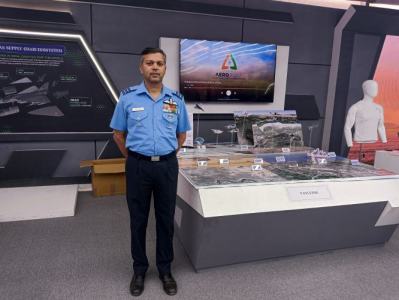Electro Optic payload (EO) and Communication Intelligence payload (COMINT) payloads mounted on Aerostat
BANGALORE (BNS): Moving out for the first time from its base, India’s indigenously developed Aerostat “Akash Deep” made its debut at the aeroshow at Yelahanka Air Force station.
DRDO's Agra-based Aerial Delivery Research and Development Establishment (ADRDE) laboratory has developed India’s new ‘eye in the sky’ to help strengthen the air defence network of the armed forces and boost the country's surveillance capabilities.
Demonstrating the medium size, 2000 cubic meter Helium aerostat based Surveillance System with Electro-optic (EO) payload and Communication intelligence (COMINT) payload, Wing Commander A Marwaha said, “We are here to show that it is fully mobile.”
The aerostat has successfully flight tested up to 1 km altitude at Agra with payload capacity of 300 kg. “The aerostat can be deployed anywhere, can carry any payload and can intercept enemy conversations. It has been built to go up to 400 metres,” said Amitabh Pal, Deputy Director ADRDE.
ADRDE plans to build up to 17000 cubic meter helium aerostat from the present 2000 cubic meter and is exploiting the platform for integration of new payloads like Electronics intelligence (ELINT) and radar as per user requirements, he said.
Aerostat radars help in enhancing the situational awareness of the theatre commanders to detect hostile aircraft and can be decisive in aerial combat operations by effectively positioning air defence fighters against them.
Ground based sensors have limited line of sight (LOS) range due to the limitations posed by earth’s curvature. Mounting these sensors on elevated platforms could increase the LOS range.
Aerostats have been proved excellent platforms for these sensors especially in surveillance and communication role for a variety of civil and military applications.
The radars on Aerostats can be operated either in a 360 degree search mode and can stay afloat round-the-clock for four to five weeks at one go.
The aerostat system mainly comprises of aerodynamic shaped balloon, winching and mooring platform, aerostat health monitoring system, helium based gas management system, power conducting/fiber conducting tether & fiber optic conducting rotary joints, Ground support systems and payloads.
Presently India has two EL/M-2083s Aerostat radar systems (also called blimps) of Israeli origin.
 Previous Article
Previous Article Next Article
Next Article













The Indian Air Force, in its flight trials evaluation report submitted before the Defence Ministry l..
view articleAn insight into the Medium Multi-Role Combat Aircraft competition...
view articleSky enthusiasts can now spot the International Space Station (ISS) commanded by Indian-American astr..
view article